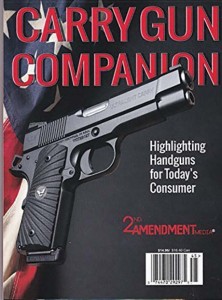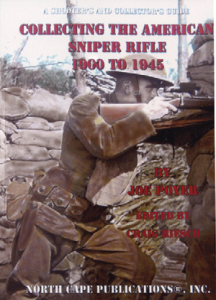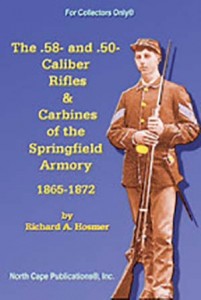Review by Larry S. Sterett | Contributing Editor
CARRY GUN COMPANION
Highlighting Handguns for Today’s Consumer. ©2014. Published by the 2nd Amendment Media, Dept. TGM, Whitman Publishing, LLC, 3101 Clairmont Road, Suite G, Atlanta, GA 30329. Price: $14.95, plus postage. Available at most bookstores.
 This 192-page softbound, elongated volume features, in addition to a brief introduction and two appendices, two sections—The Archive and The Armory. Both sections are illustrated with full color photographs. The Archive features popular concealed carry topics, historical and current, from a brief history of US gun laws, through the great debate—pistol vs. revolver—to justified shootings. Discussions of some famous court cases are cited, among them Kennesaw, GA, and DC vs. Heller in 2008. (This book was published prior to the concealed carry law being passed in Illinois, but lists East St. Louis, Harvey, Rockford, Carbondale, and Danville, as being on the 2014 list entitled “Top 100 Most Dangerous Cities in the U.S.” compiled from FBI statistics and population data by Neighborhoodscout.com. It would be interesting to learn if anything changes within the next few years.)
This 192-page softbound, elongated volume features, in addition to a brief introduction and two appendices, two sections—The Archive and The Armory. Both sections are illustrated with full color photographs. The Archive features popular concealed carry topics, historical and current, from a brief history of US gun laws, through the great debate—pistol vs. revolver—to justified shootings. Discussions of some famous court cases are cited, among them Kennesaw, GA, and DC vs. Heller in 2008. (This book was published prior to the concealed carry law being passed in Illinois, but lists East St. Louis, Harvey, Rockford, Carbondale, and Danville, as being on the 2014 list entitled “Top 100 Most Dangerous Cities in the U.S.” compiled from FBI statistics and population data by Neighborhoodscout.com. It would be interesting to learn if anything changes within the next few years.)
The Armory portion of this tome covers more than five dozen different handguns—pistols and revolvers—with a few paragraphs of text per handgun, a color photograph and specifications for each. The specifications generally include the caliber(s), action type, barrel length, weight, sights, capacity, MSRP and average sales price. For custom handguns, such as the Infinity Tiki, only the base price is provided.
The appendices consist of A, a list of handgun manufacturers, usually with mail and web addresses and telephone numbers, while B is a listing of gun-related organizations and publications, from A Girl and A Gun to Women & Guns. A short explanatory paragraph is devoted to each of the organizations listed in Appendix B.
This is a handy volume for prospective handgun carry owners to have available for reference. It doesn’t cover many of the older models suitable for concealed carry, such as the Colt Detective Special, Remington Model 51 (.380 ACP), and Browning models, but it still provides a good number from which to choose.
Second half of a book series on US Army, USMC sniper rifles
Review by Larry S. Sterett | Contributing Editor
COLLECTING THE AMERICAN SNIPER RIFLE 1945 TO 2000, by Joe Poyer. ©2014. Published by North Cape Publications, Inc., Dept. TGM, P. O. Box 1027, Tustin, CA 92781. (online: northcapepubs.com, or phone: 800-745-9714. Price: $24.95, plus $4.50 postage. Also available at online bookstores.
Edited by Craig Riesch and sub-titled “A Shooter’s and Collector’s Guide,” this 166-page perfect bound volume covers sniper rifles used by the US Army and Marine Corps from the end of World War II through the end of the 20th century. Following an Introduction on What Is A Real US Military Sniper Rifle? this tome features nine chapters from The M1C Sniper Rifle to The 120/M1/M2/M3 Sniperscope. It also contains five appendices, one of which is a bibliography, and eight sidebars, plus a listing of other North Cape publications.
 As with all North Cape Collector’s Guides this one is amply illustrated with top quality black and white photographs and line drawings, including some production drawings. Each chapter also contains tables of tabulated data, in addition to those tables in the appendices which are devoted to serial numbers and markings. (Earlier American sniper rifles (1900 to 1945) were covered in a previous volume by the same author.)
As with all North Cape Collector’s Guides this one is amply illustrated with top quality black and white photographs and line drawings, including some production drawings. Each chapter also contains tables of tabulated data, in addition to those tables in the appendices which are devoted to serial numbers and markings. (Earlier American sniper rifles (1900 to 1945) were covered in a previous volume by the same author.)
Sniper rifle systems entail more than just the basic rifle. Scopes, ammunition, spotting scopes, slings, stocks, and accessories all make up portions of the system, and are covered in this tome. Scopes are generally discussed in the chapter devoted to the rifle on which the scope was used, with Chapter 5 providing good coverage on the Leatherwood ART scopes. Ammunition is featured in Chapter 6, accessories in Chapter 7, and Chapter 8 is devoted to the M86 and M89 Special Operations Command sniper rifles.
This work, along with the previous volume (1900 to 1945), will provide the collector and/or shooter with the information necessary to correctly identify a real US Army or Marine Corps sniper rifle and/or scope. (Yes, there are faux sniper rifles out there. A few decades back, surplus M84 telescopic sights were available on the market for less than a sawbuck. Today, reproduction models cost a small fortune.)
This is an excellent reference volume for sniper rifle collectors, military museum curators, small arms historians, or arms collectors in general. It is well documented, illustrated, and presented, and the most thorough book currently available on the subject. In two volumes, this and the first (1900 to 1945), Joe Poyer has provided arms historians with a wealth of information on a century of US Army and USMC sniper rifles.
History of 19th C. military arms
Review by Larry S. Sterett | Contributing Editor
THE .58- AND .50-CALIBER RIFLES & CARBINES OF THE SPRINGFIELD ARMORY 1865-1872, by Richard A. Hosmer. Published by North Cape Publications, Inc., Dept. TGM, PO Box 1027, Tustin, CA 92781. Price: $19.95, plus $4.00 postage.
This 288-page softbound volume For Collectors Only is the word on th e US military long arms following the Civil War. The trend was toward a smaller caliber, rather than the .69 bores which had been common previously and many of which saw use in the war years. These smaller bore arms were often called the First Allin Alteration, and while metallic cartridges had been used in some Civil War rifles and carbines, such as the Spencer, Henry, etc., the new Allin conversion was different. This volume contains the story of the arms which led to what became known as the ‘trapdoor’ Springfield rifle and carbine and the .45-70 Government or Springfield cartridge used by the US military for a score of years until the adoption of the smaller .30-40 Krag cartridge and the Krag rifles and carbines.
e US military long arms following the Civil War. The trend was toward a smaller caliber, rather than the .69 bores which had been common previously and many of which saw use in the war years. These smaller bore arms were often called the First Allin Alteration, and while metallic cartridges had been used in some Civil War rifles and carbines, such as the Spencer, Henry, etc., the new Allin conversion was different. This volume contains the story of the arms which led to what became known as the ‘trapdoor’ Springfield rifle and carbine and the .45-70 Government or Springfield cartridge used by the US military for a score of years until the adoption of the smaller .30-40 Krag cartridge and the Krag rifles and carbines.
Divided into 21 chapters, each sub-divided into various sub-topics, this book contains five indices, and a listing of the North Cape publications. It is amply illustrated with black and white photographs, many of them close-up views showing specific features, plus line drawings or sketches when needed. All photographs are captioned. (The photographic quality is excellent, with wood grain and markings readily visible.) There are also more than 20 tables providing such information as finishes on various parts, dimensions, and markings.
The Introduction preceding the chapters in this volume defines the arms covered, and the ‘how and why’ of the textual material following. (Covered in this volume are the four .58- and .50-caliber rifles adopted for general issue, the four cadet rifles used at the military academies, plus high schools and colleges at which military training was provided, and the dozen rifles and carbines being subjected to trial for the next-generation rifle for the military.) It’s an excellent presentation, as even the method of screw-hole measurements are covered, as are the document spelling as originally published.
The first 18 chapters are devoted to the various long arms, while chapters 19, 20, and 21 are devoted to the accoutrements, bayonets, and ammunition for said arms. These chapters are also amply illustrated with photos of various cartridge types, packaging, and even primer types.
The appendices feature serial number ranges for the various models, finishes, dimensions, a glossary, and a bibliography. The data in appendices A, B, and C are arranged in tables, while D and E are not. The glossary ranges from Band Spring to White, or “In the white.”
This is an excellent volume on the subject. It should be on the reference shelf of any collector of military long arms, museum curator, arms historian, or even any blackpowder shooter who may own a .50-70 Remington Rolling Block, a Ward-Burton, or Spencer in .50- or .58-caliber.



